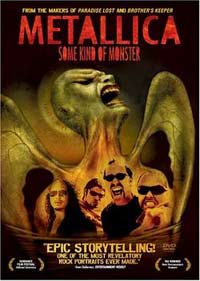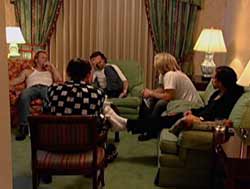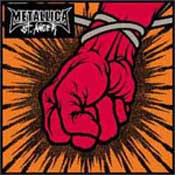
Joe Berlinger and Bruce Sinofsky’s Metallica: Some Kind of Monster (2003) was one of a number of Metallica-related works to appear during the past several years. In addition to the film, Metallica benefited from the exposure provided by an MTV Icon award show and two books: a new unofficial biography (McIver) and an official biographical compilation of material from the band’s fan club magazine (Chirazi). Aside from St. Anger, Metallica’s latest album (2003) and the base around which all of this other material orbits, Some Kind Of Monster clearly had the broadest cultural reach. The books primarily targeted fans of the band; Some Kind Of Monster, on the other hand, played at numerous film festivals in Europe and the United States and thus reached a wider range of people, from diehard Metallica fans, to film devotees, and other music fans in the general public. Moreover, the film belongs to the cultural space carved out by VH1’s Behind the Music series and the general popularity of unscripted “reality” television. Originally envisioned as a relatively straightforward documentary on the making of Metallica’s forthcoming album, Some Kind of Monster was to have been something of a publicity puff piece, rolled out along with other marketing ideas as part of the album’s release and then forgotten. Berlinger and Sinofsky, though, brought their experience with in-depth cinema verité to the project, enabling them to adapt to and embrace the tumultuous developments that arose during shooting.1 The “story” of Some Kind of Monster thus becomes much more than a behind-the-scenes all-access pass into Metallica’s musical space. Skillful editing has sculpted the various threads of the film into beginnings, middles, and endings, and the result powerfully explores one moment among the ever-present contradictions, complexities, and nuances that comprise Metallica’s musical identity. The following review unpacks some of those threads in order to arrive at an understanding of how they are also a crucial component in the structuring of that identity.

The group therapy storyline that runs throughout the film, involving performance coach Phil Towle, has been its most noteworthy element. The hyper-individualistaspect of contemporary society implicitly views therapy for the sane with unease, as a sign of weakness. The apparent contradiction of self-confident rock stars undergoing agonizing group therapy fascinates us. This is especially true in heavy metal, where music and lyrics constantly emphasize the struggle of individuality against a range of oppressive or conformist social forces. Participants are expected to solve their own problems. As such, therapy (whether individual or group) can be seen as representing a failure of self-definition and personal independence, two of metal’s most significant themes. Slayer guitarist Kerry King dismissed Metallica’s activities in these general terms, saying, “No way would you catch [Slayer] talking to someone about things that aren’t working right. If you can’t handle your own (expletive) problems, then too bad.”2 Therapy in this instance is also a feminizing influence, destabilizing metal’s traditional representations of masculine “strength.” Indeed, in Some Kind Of Monster, Jason Newsted (Metallica’s former bass player) explicitly describes the decision to work with Towle as “weak.” To be sure, Newsted was not the only member of the band with reservations about Towle, but only Newsted responded to the situation by leaving Metallica. Derisively referring to him as a “psychotherapist” Newsted believed Towle represented an intrusion and a kind of meddling in the band’s affairs that only brought his struggles with the others (James Hetfield in particular) to a breaking point.3
Newsted’s decision to quit Metallica is acknowledged by the band and the filmmakers as the unexpected catalyst that eventually brought the rest of the band together. Yet, within the larger group therapy arc lies the story of Hetfield’s individual struggle, and it is Hetfield’s story that largely drives the film. Berlinger and Sinofsky put him in the driver’s seat, and instead of ignoring his personal issues by focusing on the album-making process alone. the film depicts Hetfield as ultimately in control of everything. The directors describe his sudden decision to enter a rehabilitation program as a complex event for their project: initially hired by Elektra Records to produce a publicity film about the making of Metallica’s new album, Hetfield’s eleven-month absence became a crossroads for them. The filmmakers admit to a certain amount of Schadenfreude with respect to Hetfield’s rehab and the potential it enabled for a more compelling film.4

At the same time, Hetfield’s absence put many other lives on hold, from the filmmakers themselves, to drummer Lars Ulrich and lead guitarist Kirk Hammett, to producer Bob Rock. Rock and the filmmakers decided to refuse large gigs while Hetfield was away, believing that he could reappear at any moment to begin the resumption of both the film and the album. Some Kind Of Monster certainly acknowledges the significance of the missing Hetfield, but at this point it also clearly becomes a film in search of a story. With Hetfield gone and the future of the band uncertain the film itself is in limbo. All work on the album stops in its tracks and at this point we’re suddenly watching a very different kind of film than when we began. Hetfield’s absence forces the filmmakers to shoot many scenes entirely unrelated to the making of the next Metallica record. Audiences are thus treated to scenes such as Ulrich showing a newly purchased piece of land to his father, Hammett riding horses on his estate, Ulrich and Hammett working with rapper Ja Rule and producer Swiz Beats on a project involving samples of Metallica’s latest demos, and (though it occurs much later in the film) Ulrich selling much of his art collection.5
However, the filmmakers’ inclusion of Torben Ulrich, Lars’ father, nevertheless works to fill out the son’s personal background in a way that differs from the “biopic” feel of earlier introductory scenes. In an impromptu therapy session on his new hillside, Lars tells of the great respect he has for his father’s opinion. Among Metallica fans, Torben commands a great deal of respect as well, mostly due to his unwavering support for his son and his soft-spoken, understated nature. When Lars nervously remarks that Torben can see through any false effort when it comes to the music of Metallica, the filmmakers set us up to hear what comes next as at least “bad” if not “terrible.” The track Lars chooses to play for Torben in the next scene is a slow, jam-oriented selection [View Excerpt 1] featuring prominent reverb and vocalizations. Afterward, Lars notes that the band’s management thought the track should open the new album. However, over this music the film intercuts images of Towle sitting in a corner nodding his head, trancelike with eyes closed, and Torben, very much awake, sitting on the couch with a look of bemusement in his eyes. His response is simply, “delete that.” The track’s quasi-mystical atmosphere certainly sounds unusual in terms of the popular conception of Metallica’s music, but the scene’s visuals (from the desperately groovy Towle to the skeptical Torben) present the music as a failure. Indeed, the filmmakers acknowledge in their commentary that they generally thought the early writing sessions hadn’t produced much good music, and as such the music we do hear in scenes of band tension or frustration is also coded as bad [View Excerpt 2]. The musical underscore acts in these instances like an anchor, dragging the band down into the crisis of Hetfield’s departure and his lengthy absence.
Like other rock album documentaries (Aerosmith’s The Making of Pump (1990) is only the first to come to mind), Some Kind Of Monster captures instances of unfiltered inspiration and creation. This is especially true in moments when St. Anger song titles or noteworthy lyric phrases first come into being: the title phrase itself “Some Kind of Monster,”mentioned during a lyric writing session early in the film [View Excerpt 3]; or “wash your back so you don’t stab mine” from the song “Sweet Amber,” from Hetfield’s incredulity over the (un)ethics of a local radio station [View Excerpt 4]. In the case of “Sweet Amber,” moreover, the film encourages the audience to side with the band against the “evil” radio industry (and by implication, any doubters of the group’s vitality) through the use of a visual montage of studio activity immediately following Hetfield’s statement and underscored with an aggressive soundtrack. Largely due to our new allegiance and confidence in the band, we’re also to hear this particular music example as “good.”

With the album’s progress secure, a humorous group-bonding scene involving the recording of a radio promotion establishes, as though by fiat, the band’s internal rifts healed, and Some Kind of Monster thus begins to move toward Towle’s exit. He has begun to wear out his welcome, we understand, especially with producer Bob Rock, who is in charge of the studio activities. We see shots of Towle passing Hetfield lyric suggestions and placing inspirational slogans at various spots around the studio, much to Rock’s dismay. Finally, like something out of the Gong Show, the film cuts off his explanation of a quasi-meditative “zone” mid-sentence with a loopy jazz-sounding studio outtake that also underscores his sign-placing activities [View Excerpt 5]. The “cheesy” music directs us to a similar interpretation of Towle at this point, and as such the film (perhaps unwittingly) aligns him with previous “meddlers” such as Yoko Ono or even David St. Hubbins’s astrologically minded wife-cum-manager, Jeanine Pettibone, in Spinal Tap.6 Towle (and by extension, therapy) has essentially been the female protagonist of Some Kind Of Monster, and like those women, he is ultimately unable to remain part of the boys club environment of the rock band. Not surprisingly, Hetfield and Ulrich together actively resist Towle’s threat in what represents a crucial moment in the rebuilding of their own relationship.
The final large section of the film is devoted to Metallica’s search for a new bass player and the band’s return to live performance. With the therapy storyline essentially tied off, the film coasts into a triumphant and entertaining ending as they select Robert Trujillo to join the band and the release of St. Anger.7 Having resisted putting the band onstage prior to completing the album, Some Kind Of Monster closes with Metallica taking the stage on the first leg of the Madly In Anger tour.8 The sense of triumph, of a successful journey, is presented one last time through the person of James Hetfield, standing alone on the side of the stage pumping himself up to the soaring melody of Ennio Morricone’s “Ecstasy of Gold” [View Excerpt 6] (from the western The Good, The Bad and the Ugly). Metallica’s concert introduction since 1984, “Ecstasy of Gold” here both symbolizes the restoration of Hetfield’s individuality and acts as the musical code asserting the ultimate renewal of the band.
WORKS CITED
Books and Articles
Chirazi, Stephen, ed. So What!: The Good, the Mad, and the Ugly.New York: Broadway, 2004.
Dansby, Andrew. “Slayer: Steady Metal.” The Houston ChronicleDecember 2 2004: Preview 4.
McIver, Joel. Justice for All: The Truth About Metallica. London: Omnibus Press, 2004.
Films
The Good, the Bad, and the Ugly. Dir. Sergio Leone. Perf. Clint Eastwood, Eli Wallach, and Lee Van Cleef. United Artists, 1966.
Brother’s Keeper. Dir. Joe Berlinger, Bruce Sinofsky. New Video, 1992.
Paradise Lost: The Child Murders at Robin Hood Hills. Dir. Joe Berlinger, Bruce Sinofsky. HBO, 1996.
- Berlinger and Sinofsky first made a name for themselves with the films Brother’s Keeper (1992) and Paradise Lost: The Child Murders at Robin Hood Hills (1996). The filmmakers established a relationship with Metallica when they requested permission to use some Metallica songs in Paradise Lost. ↩
- Berliner and Sinovsky first made a name for themselves with the films Brother’s Keeper (1992) and Paradise Lost: The Child Murders at Robin Hood Hills (1996). The filmmakers established a relationship with Metallica when they requested permission to use some Metallica songs in Paradise Lost. ↩
- Metallica’s management actually hired Towle on the band’s behalf and urged its cooperation. In this light, Newsted’s objection to Towle’s presence as an intrusion appears slightly more defensible. ↩
- Once the intra-band turmoil had become central to the film-in-progress, Elektra ordered the footage made into a reality television show, following the recent success of The Osbournes. The label quickly backed down from that idea once the technical hurdles were made clear by the filmmakers, and Elektra ended up selling the film outright to Metallica to do with as it saw fit. ↩
- This last item was not included in the theatrical release but does appear as part of the large amount of additional footage on the DVD. ↩
- During what is essentially his “death” scene (Chapter 33), Towle desperately tries to hang on by telling the band members that he can still be useful because he’s prepared personalized performance notes for each of them. It’s amusingly similar to the personalized astrological charts Pettibone prepares for each member of Spinal Tap. ↩
- Towle appears in several shots following his supposed “death,” and indeed accompanied the band for the first couple of weeks of touring. ↩
- There were two short unannounced gigs with Bob Rock on bass in 2002, as well as four concerts at The Fillmore in San Francisco prior to the world tour. Footage from these shows, as well as potential plot developments that had to be ignored because the shows themselves were going to be ignored, are included among the DVD√s extensive deleted scenes. ↩
